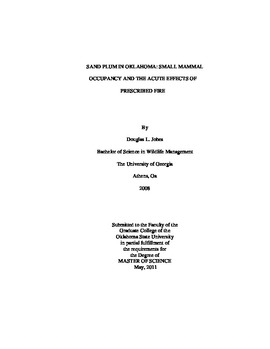| dc.contributor.advisor | Guthery, Fred S. | |
| dc.contributor.author | Jobes, Douglas L. | |
| dc.date.accessioned | 2014-04-15T21:59:46Z | |
| dc.date.available | 2014-04-15T21:59:46Z | |
| dc.date.issued | 2011-05-01 | |
| dc.identifier.uri | https://hdl.handle.net/11244/9177 | |
| dc.description.abstract | I collected stem density estimates in plum thickets using two methods to identify the relation between the two, trapped small mammals in and outside of plum thickets to determine what species occupy plum and what influencing characteristics occur in thickets, and collected data before and after prescribed burning to describe changes that occur after fire is applied to plum thickets. Thickets showed minimal variation in stem density estimates averaging 4.8/m2 (95% CL = 4.5-5.1/m2) for the quadrat-count method, and 5.6/m2 (95% CL = 5.3-5.9/m2) for the point-centerd quarter method (PCQ). Correlation between the 2 estimate techniques occurred, the linear regression model given quadrat-count estimates as afunction of PCQ estimates showed stem density estimates from the PCQ method were larger than quadrat count across stem densities. Occupancy of Ord's kangaroo rat (Dipodomys ordii), fulvous harvest mouse (Reithrodontomys fulvescens), and northern pygmy mouse (Baiomys taylori) was predicted by characteristics associated with plum thickets and by plum presence. These included minimal substrate accumulation, high angle of obstruction and visual obstruction, and increased amounts of exposed soil. The hispid cotton rat (Sigmodon hispidus) and white-footed mouse (Peromyscus leucopus) displayed a more general pattern with a high probability of occupancy in open areas and woody cover other than plum. Thickets with lower pre-burn stem densities were associated with higher levels of percent top-kill (r2 = 0.78). No mortality was identified for all thickets (n = 31), and all burned thickets returned to their pre-burn area within 1 season. Based on estimates obtained from the mean of multiple samples for each thicket, densities increased above pre-burn levels from 5.0/m2 to 10.3/m2 within 2 seasons. Density estimates from another site indicated pre-burn levels were 6.2/m2 and 10.1/m2 at the end of 1 season. Resprouts showed rapid growth in height after 1 season averaging 37.8 cm. Sampling in burned thickets showed minimal change in grass coverage during the first year. However, an increase from 33.1% to 53.1% occurred after 2 seasons. | |
| dc.format | application/pdf | |
| dc.language | en_US | |
| dc.publisher | Oklahoma State University | |
| dc.rights | Copyright is held by the author who has granted the Oklahoma State University Library the non-exclusive right to share this material in its institutional repository. Contact Digital Library Services at lib-dls@okstate.edu or 405-744-9161 for the permission policy on the use, reproduction or distribution of this material. | |
| dc.title | Sand Plum in Oklahoma: Small Mammal Occupancy and the Acute Effects of Prescribed Fire | |
| dc.type | text | |
| dc.contributor.committeeMember | Fuhlendorf, Samuel D. | |
| dc.contributor.committeeMember | McBee, Karen | |
| osu.filename | Jobes_okstate_0664M_11159.pdf | |
| osu.college | Agricultural Sciences and Natural Resources | |
| osu.accesstype | Open Access | |
| dc.description.department | Department of Natural Resource Ecology and Management | |
| dc.type.genre | Thesis | |
| dc.subject.keywords | prescribed fire | |
| dc.subject.keywords | sand plum | |
| dc.subject.keywords | small mammals | |
